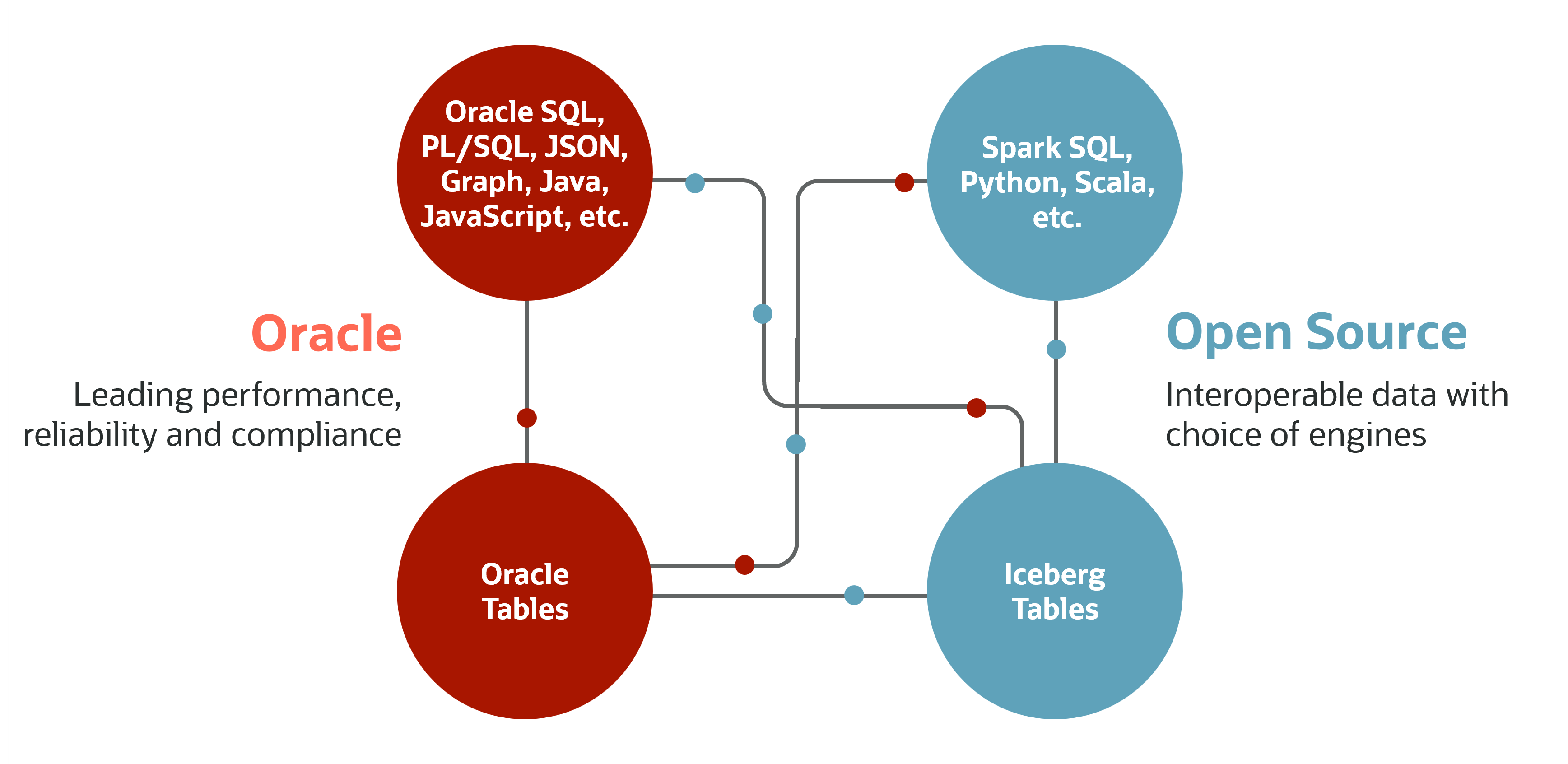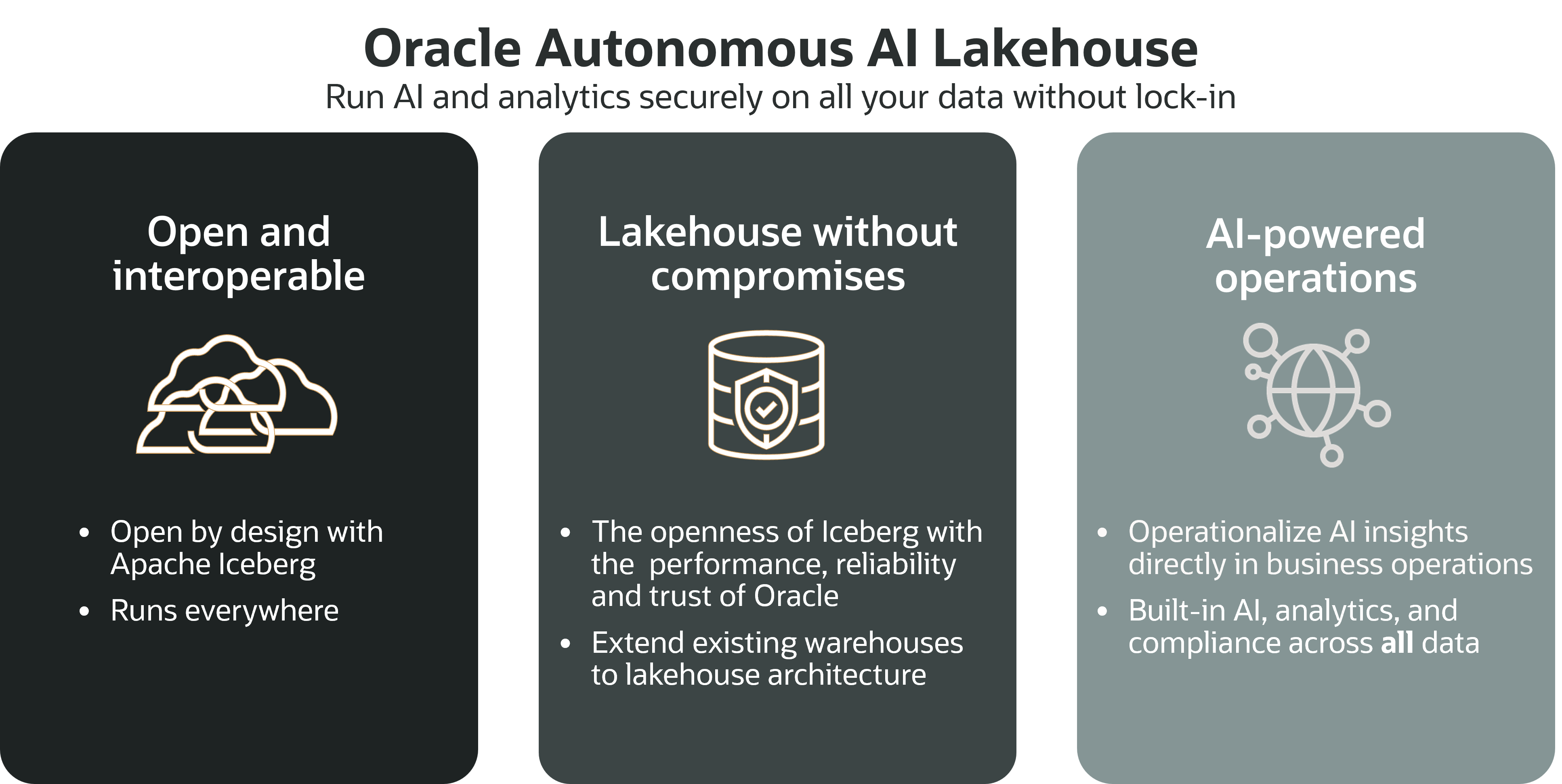Today, many organizations’ enterprise data assets are still locked in proprietary data storage and are only accessible via a single engine. Supporting multiple data engines often requires duplicating data and maintaining complex pipelines, adding inefficiencies to the enterprise data architecture. Open table formats such as Apache Iceberg are, therefore, immensely appealing to organizations because they offer the promise of complete data interoperability and the elimination of data lock-in.
However, the promise of open table formats has not yet been fulfilled. Organizations continue to rely heavily on proprietary engines to run their complex analytic workloads because of the tradeoffs with Iceberg in areas such as performance, concurrency, updatability, and security.
Autonomous AI Lakehouse now delivers a data platform without compromises—offering all the performance, reliability, and trust of the Oracle AI Database with the openness and interoperability of Iceberg. Now available on OCI, AWS, Microsoft Azure, and Google Cloud, Autonomous AI Lakehouse empowers organizations to maximize the value of their data on an open, interoperable platform.
A New Era of Data Management
Iceberg-based platforms are known for their openness, enabling compatibility with open-source tools and analytics engines (such as Spark), as well as their support for popular data formats such as Parquet, CSV, JSON, and Avro on scalable, low-cost object storage. The Oracle data platform has earned the trust of enterprises for its converged architecture, supporting all leading data types and advanced SQL analytics running on the secure, high-performance Exadata system.

Now, with Oracle Autonomous AI Lakehouse, organizations no longer need to sacrifice performance, reliability, or trust for openness—you get the best of both worlds.
Unifying Data and Accelerating AI
Autonomous AI Lakehouse is the next generation of Autonomous Data Warehouse. It retains all the functionality of the Oracle AI Database platform — with more than 40 years of innovation—and introduces a number of new capabilities that tightly integrate with Iceberg and other open-source technologies. For example, Autonomous AI Database Catalog, a “catalog of catalogs,” makes it simple to discover, connect, and unify data and metadata across clouds, platforms, and catalogs such as Databricks Unity, AWS Glue, and Snowflake Polaris. With this Catalog, teams can now rapidly discover, access, and analyze all enterprise data assets with ease regardless of where they are. Native Iceberg support delivers plug-and-play, high-performance SQL access to any Iceberg table, without data movement or vendor lock-in. During query executions, the Autonomous AI Database Data Lake Accelerator dynamically scales compute and network bandwidth for fast, efficient queries with flexible, pay-as-you-go billing.
Key new features of Oracle Autonomous AI Lakehouse include:
Catalog and lakehouse metadata
- Autonomous AI Database Catalog: Gain a unified view of enterprise data across multiple clouds and on-premises assets. With simple connectivity to data lakes, warehouses, data shares, and existing catalogs, it enables rapid data discovery, enrichment, and collaboration.
- Plug-and-Play SQL access: Query data instantly i n Iceberg and other catalogs (such as AWS, Databricks, and Snowflake) using new simple SQL syntax via catalog connections, delivering fast insights with zero data movement.
Performance for Iceberg tables
- Autonomous AI Database Data Lake Accelerator: Execute large-scale queries efficiently across Iceberg tables and object store data, as the accelerator automatically and transparently allocates additional network and compute resources to optimize speed. Costs are optimized through pay-as-you-go billing—activated during query execution and deactivated afterwards.
- Exadata table cache: Boost Iceberg data performance by caching frequently accessed tables in Oracle Exadata flash storage, delivering the performance of native Exadata tables.
AI innovation
- Select AI Agent: Build, deploy, and manage AI-powered agents using a simple, secure, and scalable framework within Autonomous AI Database. Automate multi-step workflows through custom and pre-built PL/SQL tools, external tools via REST, and MCP Servers to drive rapid AI innovation.
- Data Science Agent: Use a pre-built AI assistant to search data catalogs, prepare and explore data, uncover key insights, and transform them into actionable insights—all through natural language.
Data integration and sharing
- Oracle GoldenGate for Iceberg: Stream data in real-time from hundreds of sources, including operational and analytic systems, directly into Iceberg, enabling organizations to analyze it using Autonomous AI Lakehouse.
- Autonomous AI Database Table Hyperlink: Share up-to-date data securely within or beyond your organization with temporary direct links, streamlining collaboration while protecting data privacy.
“Customers consistently tell us they want to use the tools they already have on top of their data. Databricks is committed to open and interoperable data access for analytics and AI, and Unity Catalog helps make that possible by providing a unified governance layer for formats like Apache Iceberg. We welcome Oracle Autonomous AI Lakehouse’s integration with Unity Catalog, giving joint customers seamless access to their data and the flexibility to use Oracle and Databricks together.” —Stephen Orban, SVP, Product Ecosystem & Partnerships, Databricks
Get Deeper Insights Across All Your Data
Access to data matters only when you gain actionable insights: Oracle AI Lakehouse has unlocked vast new capabilities for Iceberg tables, all based on the converged Data Platform. Oracle AI Lakehouse delivers the full power of Oracle AI Database for Iceberg tables. You can use sophisticated analytics and AppDev features—such as AI Vector Search, graph analytics, spatial analytics, machine learning, JSON Relational Duality Views, and more—over your Iceberg tables. You can ask natural language questions on Iceberg data and create agentic workflows using Select AI.
The Oracle Difference: Lakehouse Without Compromises
Autonomous AI Lakehouse delivers benefits in three key areas:
- Open and interoperable: Autonomous AI Lakehouse has complete support for Iceberg tables, meeting organizations’ need for a data platform without data lock-in. Additionally, Autonomous AI Lakehouse offers openness in its choice of cloud platform. Regardless of which cloud platform your organization is using today—whether it’s AWS, Azure, Google Cloud, or OCI–, you can use Autonomous AI Lakehouse and connect to Iceberg tables on Databricks, Snowflake, or any other platform.
- Lakehouse without compromises: Autonomous AI Lakehouse embraces the openness of Iceberg and combines it with the performance, reliability, and trust of an Oracle AI Database. Autonomous AI Lakehouse also provides the ideal platform for organizations to evolve their on-premises data warehouse into a lakehouse, and adopt Iceberg—all at their own pace, incrementally.
- AI-powered operations: Autonomous AI Database provides Iceberg table access to every Oracle Database—whether on-premises or in the cloud, for both operational and analytics databases. This enables organizations to uncover insights hidden in Iceberg datasets and integrate them into their core operational systems using built-in AI and analytics. No other vendor offers this level of direct integration between Iceberg and transaction processing systems within core business processes.

Ready to Experience the Future of Data Management?
Visit the Autonomous AI Lakehouse page (oracle.com/ai-lakehouse), explore our technical blogs, or try Oracle Autonomous AI Lakehouse for free and discover how you can unlock new value from your enterprise data today.
For more information:
- Visit the Autonomous AI Lakehouse page (oracle.com/ai-lakehouse)
- Read the Autonomous AI Lakehouse announcement press release
- Read technical blogs for more information:
- Try Autonomous AI Lakehouse for free
